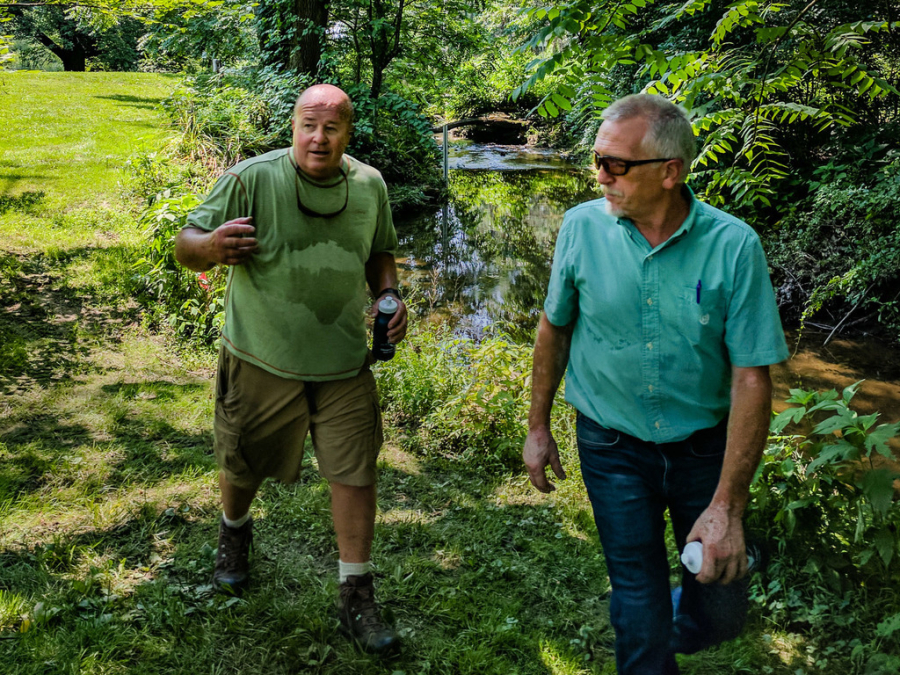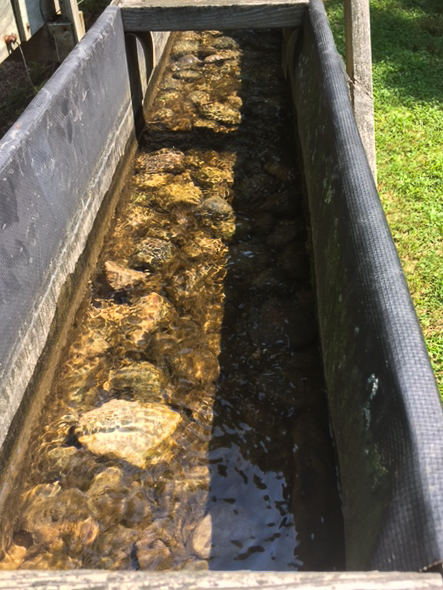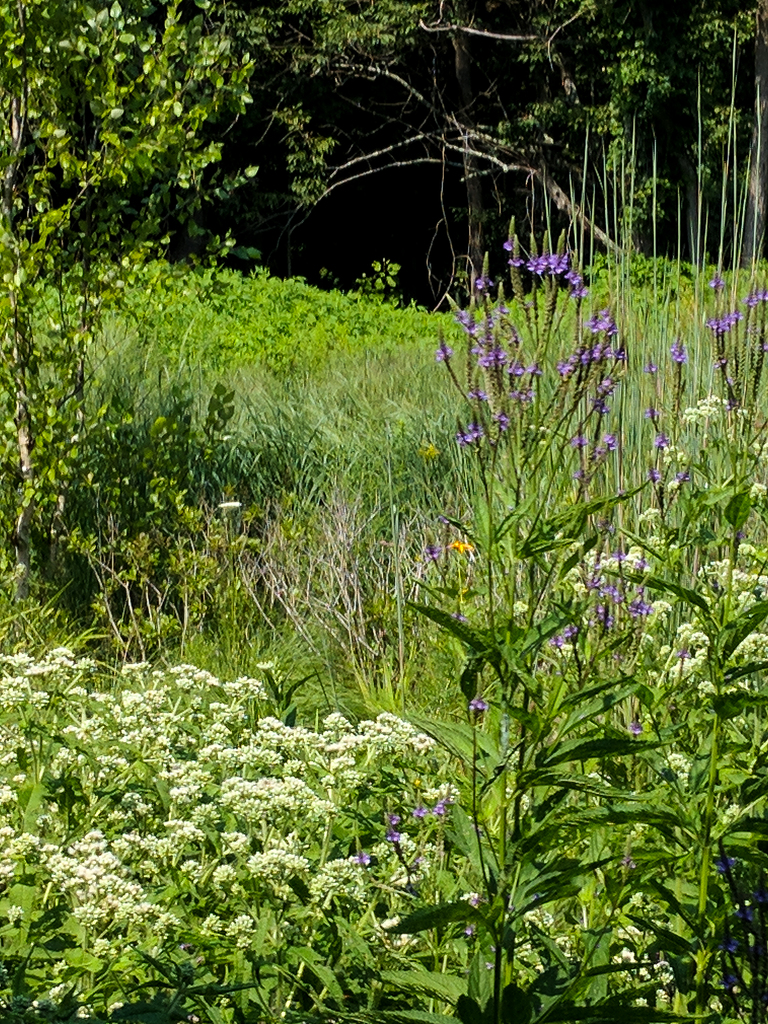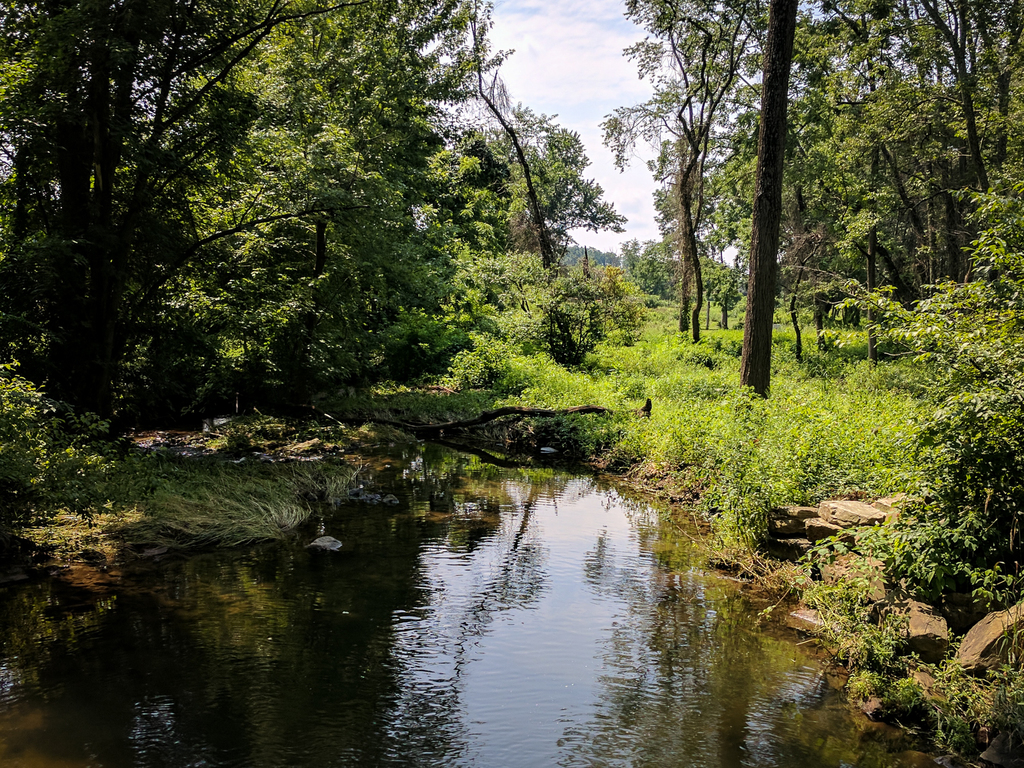Hunters, anglers and water quality
Sportsmen meet to discuss conservation July 19 at the Stroud Water Research Center

As Matt Ehrhart of the Stroud Water Research Center explains the movements of macroinvertebrates in a forested freshwater stream, four feet away, Vic and Greg aren’t listening. Vic Hurst is a dairy owner, hunter and all-around sportsman. Greg Wilson is an avid fisherman, and they’re excitedly discussing the trout potential of the Pennsylvania creek by which they stand.
“The grass roots of a meadow grab more sediment and narrow the channel” by depositing eroded land, explains Wilson. Forests, on the other hand, help the channel widen, drop the water temperature and improve the clarity and quality of the stream. “He likes it because of the bugs,” Wilson gestures to Ehrhart, and flashes a good-natured smile as Matt tips his chin back in a friendly hello. “I like the diversity with all the deep pools.”

Sportsmen and conservationists both have an interest in healthy, thriving habitats, but they rarely get the chance to meet together. They were able to do just that at a sportsmen’s listening session on July 19, held by the Chesapeake Bay Program and Alliance for the Chesapeake Bay at the Stroud Water Research Center in Avondale, Pennsylvania.
The morning began with this walk through the Stroud Center grounds, conversation morphing seamlessly from group discussion to breakout chats between two or three people. In the afternoon, all participants regrouped indoors, reviewing what came up over the walk and discussing how they could work better together in the future.
“I’ve hunted and fished my whole life,” Hurst said. “The ideal summer evening was my .22 rifle over my shoulder, a fishing rod and my dog. I grew up hunting on the farm.”
“[Conservation involvement] happens organically,” Hurst goes on to explain. “We get out there and see the runoff, the high temperatures creating algae blooms and the fish leave. We fish for suspended bass because there is no oxygen on the bottom and the surface is too dirty from runoff. You get to the point where you feel you have to do something about it.”

He and Wilson have known each other for years but had never, as Hurst put it, “hooked together along these lines.” Hurst is a proponent of having forested areas along bodies of water—called riparian buffers—and sees the benefit to both fishing and hunting.
Wilson was brought to the table by the state of a stream near which he lived, which was severely polluted. “You’d eat a caught trout and it would taste like oil,” he spat. Rather than alleviate the symptoms through methods such as stocking a poorly performing stream, Wilson was intent on rectifying the situation. Apparently, the sport is lost with the transplanted stock fish.
“I don’t have a lot of interest in stocked trout. I travel to find wild fish. Why do I have to drive three hours to go fishing? I want to do it here,” Wilson insisted. “I wish they’d put more money into conservation efforts than into fish stocking, personally.”

When placed along the borders of farms, riparian buffers can trap runoff from fields and replenish the groundwater for the land as well. Most Pennsylvanians are familiar with the surge of a stream after storms and the impact of that occurrence on farmlands. Hurst has observed the effects firsthand, reminiscing on childhood memories alongside his farmer father.
“After a cloud burst, the stream would be chocolate milk,” Hurst lamented. “I remember my dad being so upset and saying, ‘That’s our topsoil.’”
Today, Hurst and his neighbors have all put in buffers and undertaken other farming practices to improve their soil, such as contour farming—farming perpendicular to the slope of the land to keep stormwater from stripping the field —cover crops and no-till practices, which cut down on maintenance costs and encourage beneficial organisms to thrive. After a rainfall, they see a much more mild change in the rise and fall of their shared stream as the soil around it soaks up the groundwater.
“During a storm, that stream remains clear,” Hurst emphasizes, and then goes on to talk about the added benefits to his cattle health and financial bottom line. “We have seen such a dramatic [improvement] that we don’t even need to treat our water anymore.”
Forest buffers and native plants are encouraged not just as environmental best practices: they provide a secondary venture that particularly thrilled the hunters in attendance. Restored streams naturally teeming with wild fish and forests chock full of 160-inch whitetail deer are powerful draws for sportsmen—and a new, potentially lucrative source of income for landowners. A farmer in central Pennsylvania improved the quality of his land to such a degree that he charges admittance to hunters and fishermen at the rate of several hundred dollars a day.

Speaking as both a sportsman and a conservationist, Ehrhart stressed the importance of the habitat as a whole, rather than discrete terms like “nutrient reduction” or “water quality.”
“When you talk to guys, they do tell you their cows are healthier not lounging in the water, but they’re really excited about the other pieces,” Ehrhart explained. “They love birds; they’re seeing birds they haven’t seen in a while. [The landowners] are watching deer tracks appear in their buffer and get excited realizing they’re going to be able to hunt on their property for the first time in generations. Those intangible benefits are what landowners end up caring about the most.”
As the meeting came to an end, the many areas of overlap and crossover between sportsmen and conservation had barely begun to be explored. The meeting highlighted the importance of different kinds of groups coming together in collaboration—but what of economic growth? With an eye to targeting sportsmen, there was a high level of excitement among the locals on the prospect of turning small Pennsylvanian hamlets into economically thriving destination towns through environmental restoration.
Plans are underway for a larger sportsmen’s forum to be held in the fall. Keep an eye on the Alliance’s ForumPlus page or contact jmitchell@allianceforthebay.org if interested.

Comments
There are no comments.
Thank you!
Your comment has been received. Before it can be published, the comment will be reviewed by our team to ensure it adheres with our rules of engagement.
Back to recent stories